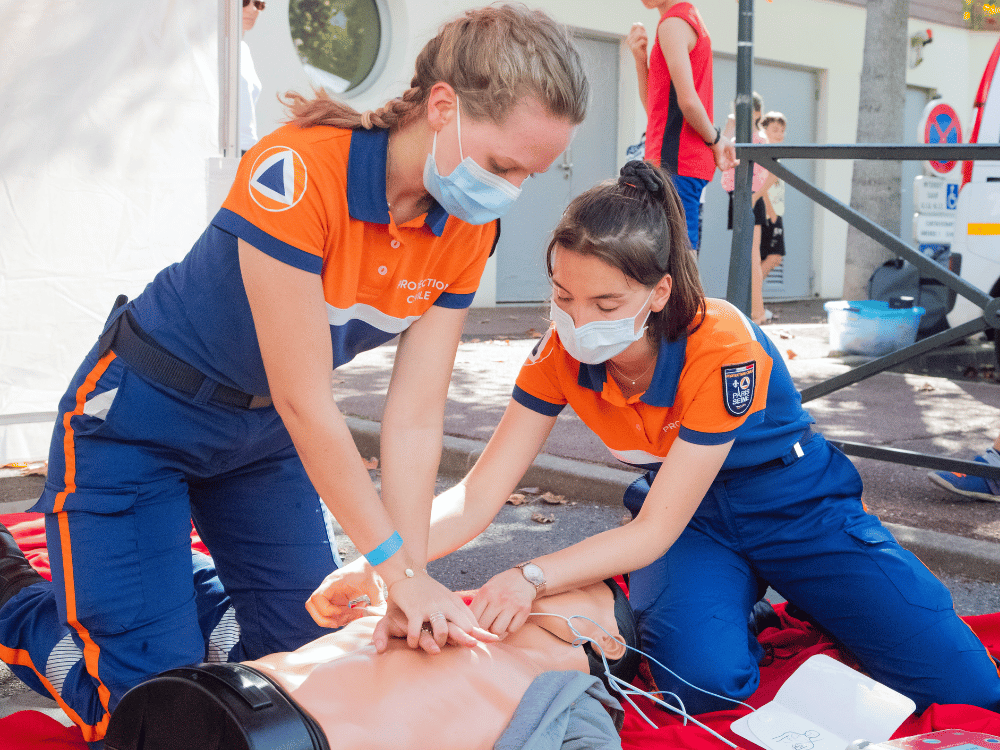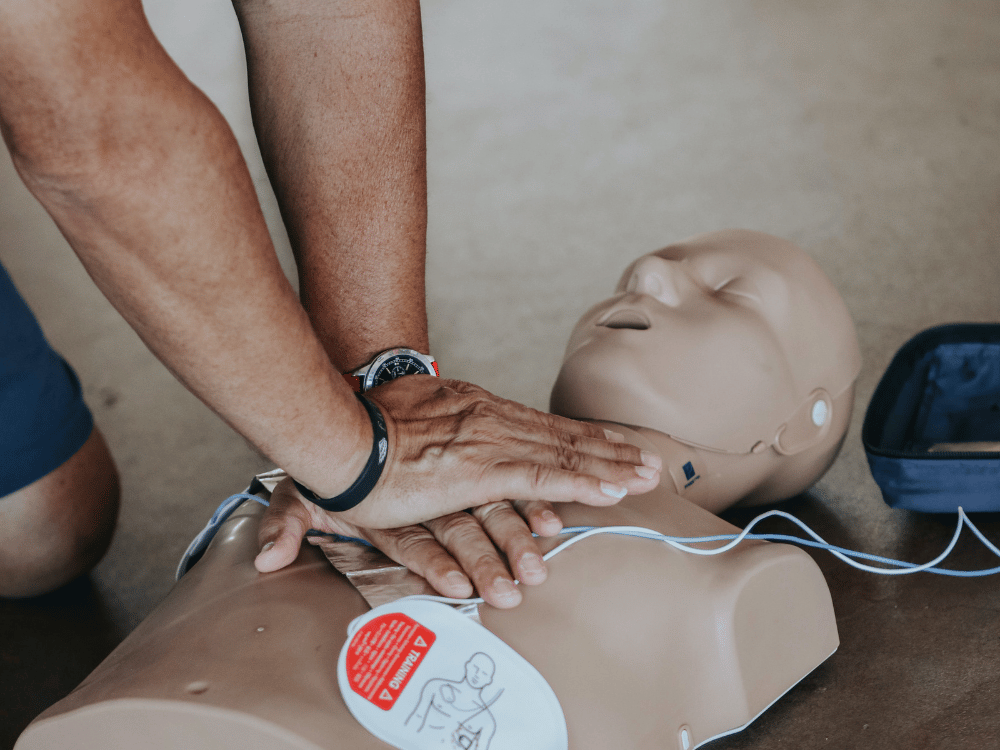According to reports under RIDDOR, around 49% of the 60,645 reported non-fatal employee injuries in 2022/23 came from slips, trips and falls or errors when handling, lifting or carrying.
Some of these injuries could have stemmed from accidental circumstances.
However, many will have been the result of behavioural safety issues.
In this blog, we’ll discuss the importance of behavioural safety and highlight some health and safety courses to improve your team’s approaches.
Plus, we’ll also understand how giving your team more control over their safety standards can improve performance and reduce absence due to injury.
What is Behavioural Safety?
Also known as ‘behaviour modification’ or ‘behaviour-based safety’, behavioural safety improves occupational safety and health standards by altering staff behaviour.
It can also have a positive effect by empowering your workforce to take responsibility for safety standards.
According to the Health and Safety at Work Act 1974, the employer’s legal obligation is to provide a safe working environment. However, the legislation also outlines that everyone in the business has a responsibility to ensure safety workplace standards are met.
Investing in behavioural-based safety training ensures staff understand their role in upholding workplace safety, as well as how to complete tasks safely and efficiently.
What is a Behavioural Safety Audit?
It helps to think of a behavioural safety audit as being like a risk assessment. However, instead of detecting hazards around the workplace, you are analysing staff behaviour and the safety of their processes.
The goal of an effective behavioural safety audit is to identify any deficiencies in workplace operational standards.
Some examples of unsafe working procedures could be staff handling hazardous substances without correct levels of PPE.
If there are instances of unsafe behaviour in your workplace, it will help to install a behavioural safety programme.
Key Features of Behavioural Safety Programme
Statistics from the Health and Safety Executive (HSE) show that workplace injuries cost businesses around £7.7 billion in 2021/22.
Structured behavioural safety programmes help minimise the risk of injury and cut down on the amount of time your workforce is not at full capacity.
However, a successful implementation should include some core elements.
Leadership Commitment and Involvement
Safety leadership can help reduce incidents by around 35%. Management buy-in is imperative to the success of a behavioural safety programme. Line managers and other senior team members must be committed to the process.
Part of this commitment is encouraging staff to report any breaches, as well as rewarding those operating in accordance with safety standards.
Another way to identify and alter unsafe behaviour in the workplace is by understanding the ABC Model:
- Antecedent: What is the element, issue or process that immediately precedes unsafe behaviour?
- Behaviour: The action or inaction that is causing concern. When assessing what is happening, it pays to be specific and highlight what safety procedures are not being followed.
- Consequence: Identifying what happens as a result of the behaviour.
Employee Engagement and Empowerment
Fostering an environment that champions employee health and safety depends on open communication.
Alongside encouraging staff to report breaches, regular employee engagement should also allow you to understand why staff work unsafely.
Deadline or workload pressures may act as catalysts for unsafe working practices. For example, if a carpenter is under pressure to finish a job, they may decide to forego necessary PPE like goggles or gloves to save time on completion – this also speaks to the antecedent element of the ABC Model we mentioned earlier.
Likewise, musculoskeletal health is a huge focus in office environments. In fact, there were an estimated 68,000 cases of work-related musculoskeletal disorders in 2021/22. Giving office-based staff access to appropriate equipment handling guides and postural comfort tools is incredibly important for tackling these statistics.
Establishing Clear Safety Goals and Objectives
Your commitment to behavioural health and safety should have quantifiable metrics attached. Targeting a reduction in incident rates is an obvious place to start.
However, other key objectives on the road to incident reduction could be scheduling regular training sessions, safety audits, risk assessments and safety catch-ups.
Again, it’s imperative to include your team in the implementation of these meetings.
Regular Monitoring and Feedback Systems
The creation of a positive health and safety culture in the workplace lives and dies on communication. There are several ways businesses can instil regular feedback opportunities.
Putting employees in charge of monitoring compliance with safe working practices is great for fostering ownership in the wider business.
Create a committee of trusted workers who meet monthly for feedback on observations.
Approaches like this also help operational departments stay across equipment stocks.
Advantages of Implementing Behavioural-Based Safety
According to Dominic Cooper, PhD – CEO of a global safety consulting firm in America;
“Behavioural safety processes are known to provide an ROI of around £1 million per 100 workers, per year from incident reductions.”
But there is a list of benefits to developing the behavioural-based safety of your workplace.
Overall Healthier Environment
One of the most obvious benefits of improving your business’s safety attitude is that it creates a much healthier workplace.
As we mentioned earlier, one step to implementing a behavioural-based safety programme is to give your staff a greater role in highlighting breaches.
Recent research by Servcorp highlighted that a leading cause of employee unhappiness is a lack of control. Therefore, happier workers mean a happier, healthier environment.
Improved Safety Culture Within the Organization
The safety culture within your business reflects how much your employees are buying into your health and safety policies and procedures.
Implementing a behaviour-based programme can help develop this culture further by enhancing policy ownership throughout the business.
Increased Productivity and Efficiency
Happy workers are 13% more productive – that’s according to a study by Oxford University.
As mentioned, giving your team more knowledge and responsibility around safety procedures can result in more content staff.
Additionally, enrolling staff in safety training courses can actually improve retention rates.
Recent studies into workplace movement have found that retention rates rise by as much as 50% for companies with strong learning cultures.
How to Frame a Behavioural Safety Policy
Enhancing behaviour and safety in your business can be driven by the policies you instil. However, there are many facets to a well-structured behavioural safety policy.
- Securing buy-in: This should come from both management and employee sides. The management team can show commitment through various catch-ups or by installing an employee-led safety committee to review and feedback on potentially risky behaviour.
- Review data and set goals: Use business data to review previous safety audit performances. Notice trends and set goals for improvement.
- Outline a critical behaviour checklist: Define what appropriate safety processes are for each role or sector of the business. We’ll talk more about this later.
- Conduct regular reviews: Schedule regular feedback sessions with the safety committee and head out on observation sessions. These sessions analyse staff conducting daily tasks to assess compliance. Take note of positive and risky behaviours, as well as areas for improvement.
- Give feedback: It’s important to then deliver your findings to the management team and staff. Remember to reward positive behaviour and offer training opportunities where improvements are required.
How to Provide Behavioural Safety Training to Employees
When conducting behavioural safety training, it’s important to work with each business area. Use general HSE safety guidance and tailored working plans for each area to inform your training.
Leverage business data to isolate recurring issues and create a process that negates incidents in that area. Show workers in those target areas the correct way to complete tasks, this will also give them the knowledge they need to spot when a role isn’t been completed safely.
One other core element of the training should be a behavioural safety checklist.
Behavioural Safety Checklist
When creating your business’s behavioural safety checklist, you aim to highlight safe and unsafe behaviours to foster a better, safer workplace culture.
Your checklist should cover:
- Safety training: Utilise qualifications like the NEBOSH National General Certificate to train staff on safe behaviours.
- Safe practices: Promote safe practices by publishing health and safety posters – these can be helpful with tasks such as heavy lifting.
- PPE: Outline what protective equipment needs to be worn, when and in which areas of the business. Be specific and leave no room for ambiguity.
- Environment: Include information about the workplace environment, including fire exits or clinical areas.
- Communication: Create a safety committee comprised of members from all business sectors.
- Incident reporting: Ensure all employees know what the incident reporting process is.
- Emergency Preparedness: Do your fire strategy plan or what to do in another emergency?
- Goal setting and improvement: Set attainable goals and measure progress regularly.
What Are The Benefits Of Using Checklists In Behavioural Safety Audits?
There are many good reasons to use checklists for safety audits. Beyond providing a simple and quickly referrable benchmark for work safety standards, they also offer accountability.
In addition, accessible checklists help negate instances of key man dependency.
If the safety officer in charge of the checklist moves on or upwards, the new incumbent has a meticulous reference point from which to continue the work.
Frequently Asked Questions (FAQs)
Here are some frequently asked questions about behavioural safety.
What is a Behavioural Safety Programme Example?
An example of a behavioural safety programme reviews both positive and risky behaviours in all areas of your business.
A strong programme requires periodical observations, subsequent reviews of risky behaviours and the implementation of goals.
What Theory is Behavioural Safety Based On?
Behavioural safety is based on Heinrich’s Triangle. According to Herbert William Heinrich’s research in 1931, there was an almost constant ratio for every 550,000 accidents in industrial settings.
Heinrich’s Triangle found that every fatality or severe injury saw 29 minor accidents and 300 near misses.
Can You Recommend a Few Behavioural Safety Courses for the Workplace?
To improve the behavioural safety of your workplace, you should consider enhancing the training of your staff.
The NEBOSH National General Certificate is an internationally recognised course which is perfect for improving safety knowledge from your management team down.
Conclusion
Improving the behavioural safety standards of your business takes time, as well as a lot of observations and implementations.
However, developing your workplace culture has many benefits, from enhancing safety standards to driving performance.
TSW Training’s range of health and safety courses will raise the awareness levels in your staff and help curate a culture of safe practice.
Meanwhile, the NEBOSH National General Certificate is ideally suited to improve the safety knowledge of your management team.













